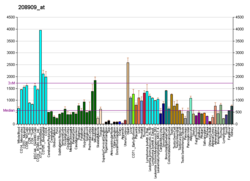| UQCRFS1 | |||||||||||||||||||||||||||||||||||||||||||||||||||
|---|---|---|---|---|---|---|---|---|---|---|---|---|---|---|---|---|---|---|---|---|---|---|---|---|---|---|---|---|---|---|---|---|---|---|---|---|---|---|---|---|---|---|---|---|---|---|---|---|---|---|---|
 | |||||||||||||||||||||||||||||||||||||||||||||||||||
| Identifiers | |||||||||||||||||||||||||||||||||||||||||||||||||||
| Aliases | UQCRFS1 , RIP1, RIS1, RISP, UQCR5, ubiquinol-cytochrome c reductase, Rieske iron-sulfur polypeptide 1, MC3DN10 | ||||||||||||||||||||||||||||||||||||||||||||||||||
| External IDs | OMIM: 191327; MGI: 1913944; HomoloGene: 4378; GeneCards: UQCRFS1; OMA:UQCRFS1 - orthologs | ||||||||||||||||||||||||||||||||||||||||||||||||||
| |||||||||||||||||||||||||||||||||||||||||||||||||||
| |||||||||||||||||||||||||||||||||||||||||||||||||||
| |||||||||||||||||||||||||||||||||||||||||||||||||||
| |||||||||||||||||||||||||||||||||||||||||||||||||||
| |||||||||||||||||||||||||||||||||||||||||||||||||||
| Wikidata | |||||||||||||||||||||||||||||||||||||||||||||||||||
| |||||||||||||||||||||||||||||||||||||||||||||||||||
Ubiquinol-cytochrome c reductase, Rieske iron-sulfur polypeptide 1, also known as UQCRFS1, Rieske iron-sulfur (Fe-S) protein, Cytochrome b-c1 complex subunit 5, or Complex III subunit 5 is a protein which in humans is encoded by the UQCRFS1 gene. [5] UQCRFS1 is a subunit of the respiratory chain protein Ubiquinol Cytochrome c Reductase (UQCR, Complex III or Cytochrome bc1 complex), which consists of both the product of one mitochondrially encoded gene, MTCYTB (mitochondrial cytochrome b) and the products of ten nuclear genes UQCRC1, UQCRC2, Cytochrome C1, UQCRFS1 (this protein, a type of Rieske protein), UQCRB, UQCRQ ("11kDa protein"), UQCRH (cyt c1 Hinge protein), UCRC ("cyt. c1 associated protein"), and UQCR ("Rieske-associated protein"). [6]























